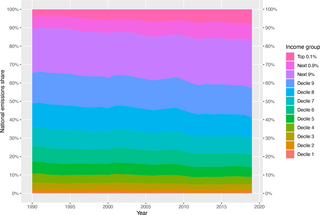103
Income-based U.S. household carbon footprints (1990–2019) offer new insights on emissions inequality and climate finance
journals.plos.orgCurrent policies to reduce greenhouse gas (GHG) emissions and increase adaptation and mitigation funding are insufficient to limit global temperature rise to 1.5°C. It is clear that further action is needed to avoid the worst impacts of climate change and achieve a just climate future. Here, we offer a new perspective on emissions responsibility and climate finance by conducting an environmentally extended input output analysis that links 30 years (1990–2019) of United States (U.S.) household-level income data to the emissions generated in creating that income. To do this we draw on over 2.8 billion inter-sectoral transfers from the Eora MRIO database to calculate both supplier- and producer-based GHG emissions intensities and connect these with detailed income and demographic data for over 5 million U.S. individuals in the IPUMS Current Population Survey. We find significant and growing emissions inequality that cuts across economic and racial lines. In 2019, fully 40% of total U.S. emissions were associated with income flows to the highest earning 10% of households. Among the highest earning 1% of households (whose income is linked to 15–17% of national emissions) investment holdings account for 38–43% of their emissions. Even when allowing for a considerable range of investment strategies, passive income accruing to this group is a major factor shaping the U.S. emissions distribution. Results suggest an alternative income or shareholder-based carbon tax, focused on investments, may have equity advantages over traditional consumer-facing cap-and-trade or carbon tax options and be a useful policy tool to encourage decarbonization while raising revenue for climate finance.


Elon’s plane burn more than 3000litres of gas each day. The more trips he make the more it burns.
https://mastodon.social/@elonjet